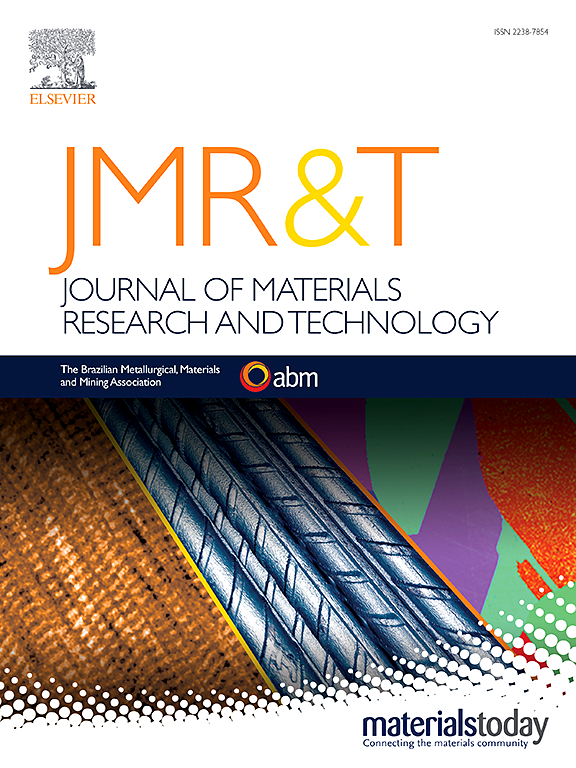Load and temperature dependent sliding wear performance of Binder Jet 3D printed stainless-steel bonded cermet
IF 6.2
2区 材料科学
Q1 MATERIALS SCIENCE, MULTIDISCIPLINARY
Journal of Materials Research and Technology-Jmr&t
Pub Date : 2025-06-13
DOI:10.1016/j.jmrt.2025.06.095
引用次数: 0
Abstract
The present study investigates the dry sliding wear behavior of the TiC-stainless steel-based cermets processed using the Binder Jet 3D Printing technique (BJ3DP). A conventional core-rim microstructure with bimodal TiC grain size was observed in the cermets sintered at 1450 °C, achieving a relative density of 99,5 %. The study explored the effect of loads (5, 10, and 20 N) and temperatures (room temperature, 100, 200, and 300 °C) on the Coefficient of Friction (CoF), wear loss, and wear mechanisms of the sintered cermets. At room temperature, a lower CoF was observed at a 5 N load, corresponding to a lower wear rate for the cermets (3,05 × 10−6 mm3/N-m). Increasing the load at room temperature resulted in a high wear rate of 4,90–5,16 × 10−6 mm3/N-m. Sliding wear tests conducted at 100 °C, 200 °C, or 300 °C resulted in a decreased CoF as compared to room temperature, but a higher wear rate (5,4–8,4 × 10−6 mm3/N-m). At room temperature, the dominant wear mechanisms were fatigue-driven delamination of the compacted debris. However, at elevated temperatures, the predominant wear mechanisms included delamination, adhesive, and oxidative wear. Scanning electron microscopy (SEM) equipped with energy dispersive spectroscopy (EDS) and a 3D surface profilometer was used to investigate the wear mechanisms and properties of the worn surface. The tribological results from the current investigation confirm the feasibility of the BJ3DP process to fabricate TiC-stainless steel cermets parts with optimal wear resistance properties at lower temperatures and loads, highlighting the potential of TiC-based cermets with a low-cost steel binder.
Binder Jet 3D打印不锈钢粘接金属陶瓷的载荷和温度相关滑动磨损性能
本研究研究了使用粘合剂喷射3D打印技术(BJ3DP)加工的tic -不锈钢基陶瓷的干滑动磨损行为。在1450°C烧结的陶瓷中观察到具有双峰TiC晶粒尺寸的常规核心-边缘组织,相对密度为99.5%。该研究探讨了载荷(5、10和20 N)和温度(室温、100、200和300°C)对烧结陶瓷摩擦系数(CoF)、磨损损失和磨损机制的影响。在室温下,在5 N载荷下观察到较低的CoF,对应于较低的金属陶瓷磨损率(3,05 × 10−6 mm3/N-m)。在室温下增加载荷导致高磨损率为4,90 - 5,16 × 10−6 mm3/N-m。在100°C、200°C或300°C下进行的滑动磨损试验结果表明,与室温相比,CoF降低,但磨损率更高(5,4 - 8,4 × 10−6 mm3/N-m)。在室温下,主要的磨损机制是疲劳驱动的压实碎片分层。然而,在高温下,主要的磨损机制包括分层、粘合和氧化磨损。利用扫描电子显微镜(SEM)、能谱仪(EDS)和三维表面轮廓仪对磨损表面的磨损机理和性能进行了研究。目前研究的摩擦学结果证实了BJ3DP工艺在较低温度和载荷下制造具有最佳耐磨性的tic -不锈钢金属陶瓷部件的可行性,突出了使用低成本钢粘结剂的tic基金属陶瓷的潜力。
本文章由计算机程序翻译,如有差异,请以英文原文为准。
求助全文
约1分钟内获得全文
求助全文
来源期刊

Journal of Materials Research and Technology-Jmr&t
Materials Science-Metals and Alloys
CiteScore
8.80
自引率
9.40%
发文量
1877
审稿时长
35 days
期刊介绍:
The Journal of Materials Research and Technology is a publication of ABM - Brazilian Metallurgical, Materials and Mining Association - and publishes four issues per year also with a free version online (www.jmrt.com.br). The journal provides an international medium for the publication of theoretical and experimental studies related to Metallurgy, Materials and Minerals research and technology. Appropriate submissions to the Journal of Materials Research and Technology should include scientific and/or engineering factors which affect processes and products in the Metallurgy, Materials and Mining areas.
 求助内容:
求助内容: 应助结果提醒方式:
应助结果提醒方式:


